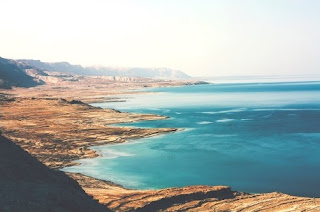Bordering Jordan, Israel, and the Palestinian West Bank, the Dead Sea is the lowest land-based elevation on earth. Its main tributary is the Jordan River flowing from the north. Because of its heavy concentration of salt, neither plant nor animal life can survive. Nor can a person floating in its waters sink.
Located approximately 16 miles (26 km) east of Jerusalem, biblically it is called the Salt Sea,1 the Sea of the Arabah (in the valley of Arabah, meaning “desolate place”),2 and the Eastern Sea (as a boundary marker).3 This is believed to be the general area where Sodom and Gomorrah once stood, and where Lot’s wife was turned into a pillar of salt (Gen. 19:15-29).
Qumran
About a mile (1.6 km) from the northwest shore of the Dead Sea, Qumran was once inhabited by what is generally believed to be the Jewish sect of the Essenes, or perhaps a reclusive Sadducean sect. Destroyed by the Romans during the first Jewish-Roman war (AD 66-73), its caves have preserved hundreds of Jewish documents (thousands of fragments) dating from the third century BC to the first century AD. Collectively known as the Dead Sea Scrolls, they include the oldest extant manuscripts of the Bible, representing every book of the Old Testament except Esther.
The best preserved is a complete copy of the scroll of Isaiah (note Luke 4:17), which is around 1,000 years older than any previously discovered biblical manuscript, confirming that the text of the Hebrew Bible has been faithfully transmitted and preserved through the ages.
Jericho
In the parable of the Good Samaritan, Jesus referenced Jericho, a city familiar to his Judean listeners (Luke 10:30). It was the home of two blind men healed by the Lord (Matt. 20:29-34), including Bartimaeus (Mark 10:46; Luke 18:35). It was also the home of Zacchaeus, the vertically-challenged tax collector who hosted Jesus and welcomed the gift of salvation (Luke 19:1-10). It was also here, before heading to Jerusalem, that the Lord told the parable of the minas, anticipating his approaching death and resurrection and the establishment of God’s kingdom (Luke 19:11-27).
Bethlehem
About 6 miles (10 km) south of Jerusalem, the “Little Town of Bethlehem” is now a bustling city of around 25,000 residents. At one time inhabited by Canaanites, this is where Jacob’s wife Rachel was buried (Gen. 35:19; 48:7). Later it was the home of David’s father Jesse and his family, where David was anointed as king (1 Sam. 16:1-13), thus one of the two places known as “the city of David” (Luke 2:4).
Bethlehem is probably best known as the birthplace of Jesus (Mic. 5:2; Matt. 2:1). At the traditional site of his birth, recognized since at least the early fourth century, stands the Church of the Nativity, dating back to the sixth century that now includes Roman Catholic, Armenian Apostolic, and Greek Orthodox monasteries.
Reflections
While present-day Bethlehem evinces centuries of human attempts to honor and memorialize what many regard as a sacred place, the plethoric shrines, basilicas, and money-making tourist enterprises have actually spoiled the simplicity and splendor of its past. On the other hand, just a few miles away, the parched and desolate surroundings of Qumran, with the priceless literary treasures preserved for centuries in its caves, remind us of how God has chosen to reveal himself and his will to humankind and has providentially ensured ready access to his word. “All flesh is as grass, and all the glory of man as the flower of the grass. The grass withers, and its flower falls away, but the word of the LORD endures forever” (1 Peter 1:24-25, NKJV).
--Kevin L. Moore
Endnotes:
1 Gen. 14:3; Num. 34:3, 12; Deut. 3:17; Josh. 3:16; 12:3; 15:2, 5; 18:19.
2 Deut. 3:17; 4:49; Josh. 3:16; 12:3; 2 Kings 14:25; Ezek. 47:8.
3 Ezek. 47:18; Joel 2:20; Zech. 14:8.
4 Num. 22:1; 26:3, 63; 31:12; 33:48, 50; 35:1; 35:1; 36:13; Deut. 32:48; 34:1.
Related Posts: Jordan Part 1, Jordan Part 2, Israel Part 1, Part 2, Part 3, Part 4, Part 5, Part 6, Part 7, Part 8, Part 9, Part 10
Related Articles or Videos: Rick Brumback, Salt Sea
Image credits:
Dead Sea, <https://pixabay.com/photos/dead-sea-sea-israel-sand-nature-4927978/>
Qumran, photo by Katie Wadlington
Jericho, <https://brewminate.com/a-history-of-early-jericho/>
Bethlehem, <https://planetofhotels.com/guide/en/palestinian-territory/bethlehem>




No comments:
Post a Comment